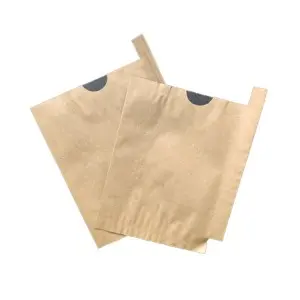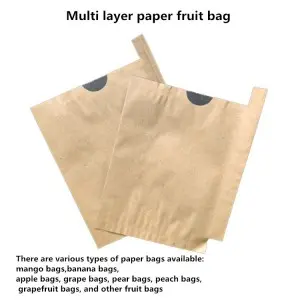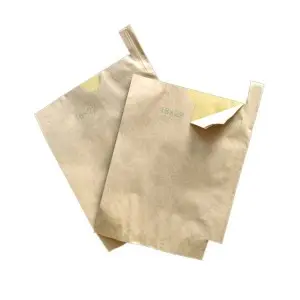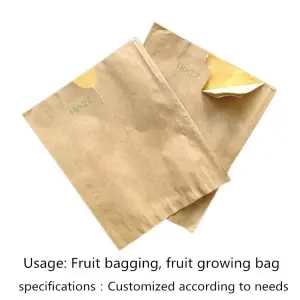ఆగ . 08, 2025 03:20 Back to list
Fruit Paper Bags: Protect from Plant Pollen & Pests
In the evolving landscape of modern agriculture, protecting crops from environmental stressors and biological threats is paramount. As growers strive for higher yields, superior quality, and reduced reliance on chemical pesticides, innovative solutions become indispensable. Among these, advanced fruit paper bags have emerged as a game-changer, offering a multifaceted approach to safeguarding developing fruits from various adversities. These specialized bags provide a physical barrier, creating a micro-environment conducive to optimal fruit development while mitigating risks from insects, birds, and adverse weather conditions. Understanding the intricate balance of nature, including the crucial role of different pollen types and the delicate process of plant pollen distribution for successful fertilization, these bags are designed to be applied post-pollination, ensuring the fruit's initial growth phase is undisturbed before providing comprehensive protection.
Global Trends in Fruit Protection & Sustainable Agriculture
The agricultural sector is currently experiencing a profound shift towards sustainability and eco-friendliness. Growing consumer demand for organically grown and pesticide-residue-free produce is driving innovation in crop protection. According to a report by Grand View Research, the global organic food and beverages market size was valued at USD 227.7 billion in 2022 and is expected to grow at a compound annual growth rate (CAGR) of 13.0% from 2023 to 2030. This trend significantly boosts the demand for physical protection methods like fruit paper bags.
Climate change further exacerbates the challenges faced by fruit growers, leading to more unpredictable weather patterns, including intense rainfall, hailstorms, and prolonged droughts, alongside shifting pest migration patterns. Furthermore, the increasing awareness regarding the impact of synthetic pesticides on human health, biodiversity, and soil quality has led to stricter regulations and a push for integrated pest management (IPM) strategies. In this context, fruit paper bags offer a non-chemical, physical barrier solution that aligns perfectly with these global trends, supporting both environmental stewardship and economic viability for farmers. They protect the fruit after the crucial period of pollination, ensuring that delicate plant pollen has completed its vital work before the bag is applied.

Introducing FRUIT BAGGING: Insect Proof, Waterproof, and Bird Proof
Our flagship product, FRUIT BAGGING, available at https://www.jmlpollen.com/fruit-bagging-insect-proof-waterproof-and-bird-proof.html, represents the pinnacle of fruit protection technology. Designed with precision engineering and high-quality materials, these bags offer an unparalleled level of defense for a wide variety of fruits. They provide comprehensive protection against a spectrum of threats, ensuring that your harvest reaches its full potential in terms of quality, appearance, and yield.
Key Technical Parameters of Advanced Fruit Paper Bags
| Parameter | Description | Typical Value/Feature | Benefit |
|---|---|---|---|
| Material Composition | Multi-layered, high-density Kraft paper with specialized coatings. Often includes a wax or polymer layer. | 2-3 plies, UV-treated, Water-resistant coating | Exceptional durability, weather resistance, and tear strength. Ensures non-toxic contact with fruit. |
| Permeability/Breathability | Designed to allow gas exchange (CO2, O2, water vapor) while blocking pests and water. | Controlled porosity, micro-perforations | Prevents fruit suffocation, maintains optimal humidity, reduces fungal diseases, allows light penetration. |
| UV Resistance | Treated to withstand prolonged exposure to sunlight without degradation. | Min. 6-month UV stability | Extends bag lifespan, prevents premature breakdown, maintains protective integrity. |
| Pest & Bird Barrier | Physical barrier against insects (fruit flies, codling moths), birds, and other small animals. | Dense fiber structure, tight closure mechanism | Significantly reduces insect damage, peck marks, and associated disease transmission. |
| Water Resistance | Repels water to prevent moisture accumulation inside the bag, protecting fruit from rot and spots. | Hydrophobic coating (e.g., wax, polymer) | Keeps fruit dry during rain, prevents water staining, reduces fungal growth. |
| Light Transmission | Allows sufficient sunlight for photosynthesis and fruit coloration while preventing sunburn. | Optimal opacity (e.g., ~70-80% light blocking) | Promotes natural ripening and coloring, prevents sun scald. |
| Size Range | Available in various dimensions to accommodate different fruit sizes and types. | Standard: 15x20cm to 25x35cm; Custom sizes available | Versatility for apples, pears, grapes, mangoes, pomegranates, etc. |
| Environmental Impact | Biodegradable or compostable options, reduced pesticide use. | FSC certified paper, non-toxic glues/coatings | Supports sustainable agriculture, reduces chemical runoff, eco-friendly disposal. |
Unveiling the Manufacturing Process of Fruit Paper Bags
The creation of high-performance fruit paper bags is a sophisticated process that combines material science, precision engineering, and rigorous quality control. It's not merely about cutting and gluing paper; it involves selecting the right raw materials, applying specialized treatments, and forming the bags to withstand harsh environmental conditions while ensuring optimal fruit development.
Key Process Highlight: The integrity of the bag's material and sealing is critical to its function. Unlike industrial components that might undergo casting or CNC machining, fruit paper bags manufacturing focuses on advanced paper lamination, precise cutting, and specialized coating applications. Each step is vital to ensure the bag can protect the fruit after the initial delicate phases involving plant pollen.
Step 1: Raw Material Sourcing & Selection
High-quality, virgin wood pulp Kraft paper is selected, often FSC (Forest Stewardship Council) certified to ensure sustainable forestry practices. This base paper typically has excellent tensile strength and tear resistance. For waterproofing, food-grade waxes or biodegradable polymer coatings are chosen. All materials must comply with international food safety standards (e.g., FDA 21 CFR 176.170 for paper and paperboard in contact with aqueous and fatty foods).
Step 2: Multi-Layer Lamination
Depending on the required protection level (insect, water, bird), multiple layers of paper may be laminated together. This process uses non-toxic, water-based adhesives. For enhanced water resistance and durability, a thin, food-grade wax layer or a bioplastic film might be co-extruded or laminated onto the paper. This creates a composite material that is strong, yet breathable.
Step 3: Precision Cutting & Forming
Large rolls of the laminated paper are fed into automated cutting machines. These machines precisely cut the paper into the desired bag shapes and sizes. Advanced CNC-controlled cutting ensures high accuracy and consistency. Simultaneously, specialized machinery folds and forms the paper into the bag shape, creating the opening and the sealing mechanism (e.g., wire ties, self-adhesive strips).
Step 4: Specialized Coating & Treatment (UV, Anti-fungal)
Post-forming, bags may undergo further treatment. A UV-stabilizing coating is applied to extend the bag's outdoor lifespan, preventing degradation from sun exposure. Some bags might receive an anti-fungal treatment (using food-safe agents) to inhibit mold and mildew growth inside the humid micro-environment, especially crucial for fruits prone to fungal infections. This step ensures the bags support a healthy environment for the fruit, long after the delicate pollen types have done their job.
Step 5: Quality Control & Inspection
Each batch of fruit paper bags undergoes stringent quality control. This includes visual inspection for defects, strength testing (tensile and tear strength), water repellency tests (e.g., Cobb test for water absorption), breathability tests, and dimensional accuracy checks. Compliance with standards like ISO 9001 (Quality Management Systems) and specific agricultural packaging guidelines ensures consistent product performance and reliability.
Step 6: Packaging & Distribution
Once approved, the bags are neatly stacked, counted, and packaged in protective cartons, ready for shipment. Efficient logistics ensure timely delivery to growers worldwide, supporting diverse agricultural cycles. The packaging also protects the bags from moisture and damage during transit, maintaining their integrity until they are applied in the orchard.
Lifespan and Applicable Industries
Our FRUIT BAGGING solutions are designed for single-season use, ensuring optimal protection for one growing cycle. The materials are engineered to maintain their structural integrity and protective properties throughout the fruit's development phase, typically from a few weeks post-pollination until harvest. Their controlled degradation properties mean they can often be composted or recycled, minimizing environmental impact.
These specialized fruit paper bags are primarily applicable across various segments of the horticulture and agriculture industries. This includes:
- Commercial Orchards: For high-value fruits like apples, pears, peaches, mangoes, pomegranates, and citrus.
- Organic Farming: As a primary non-chemical pest and disease control method.
- Small-Scale & Hobby Farmers: Providing accessible and effective protection for home gardens and small plots.
- Nursery Operations: Protecting young fruit trees and delicate grafts.

Application Scenarios and Unmatched Advantages
The versatility of FRUIT BAGGING solutions allows their application across a wide array of fruit types and growing conditions. From the early stages of fruit development, post the vital process involving pollen types and the fertilization by plant pollen, these bags offer a critical shield.
Typical Application Scenarios:
- Apples & Pears: Protecting against codling moth, apple maggot, and fungal spots like scab, while ensuring blemish-free skin.
- Grapes: Shielding bunches from bird pecking, wasp damage, and rain-induced cracking.
- Mangoes & Lychees: Preventing fruit fly infestations, sun scald, and bird damage, especially in tropical climates.
- Pomegranates: Guarding against pomegranate fruit borer and splitting due to uneven watering.
- Stone Fruits (Peaches, Plums): Minimizing Oriental fruit moth damage and preventing brown rot by reducing moisture contact.
Distinct Technical Advantages:
The "Insect Proof, Waterproof, and Bird Proof" claims are not just marketing slogans; they are inherent technical advantages built into the design and material science of our fruit paper bags:
- Superior Pest Exclusion: The dense fiber structure and tight sealing mechanism of the bag form an impenetrable physical barrier against common fruit pests such as fruit flies (Drosophila melanogaster), codling moths (Cydia pomonella), apple maggots (Rhagoletis pomonella), and various beetles. This significantly reduces the need for chemical insecticides, aligning with organic farming practices.
- Optimized Micro-Environment (Waterproof yet Breathable): While the outer layer is highly water-resistant, repelling rain and dew to prevent moisture-related diseases (e.g., fungal growth, water spots), the bag's engineered porosity allows for sufficient gas exchange. This critical balance ensures the fruit "breathes," preventing anaerobic conditions, internal rot, and off-flavors, maintaining optimal humidity for healthy development without compromising on protection.
- Effective Bird Deterrence: Birds are significant vectors of fruit loss. The opaque and durable nature of the bag physically prevents birds from pecking at and damaging the ripening fruit. This mechanical barrier is humane and highly effective, safeguarding your yield from avian predation.
- Sun Scald & Wind Abrasion Prevention: The bags provide a moderate level of shade, protecting fruits from direct, intense sunlight that can cause sun scald, especially in sensitive varieties or hot climates. They also shield the fruit from wind rub and abrasion, preserving the pristine quality of the fruit skin.
- Reduced Chemical Residues: By drastically minimizing or eliminating the need for pesticide sprays on the fruit itself, these bags contribute directly to producing cleaner, safer, and more marketable produce, benefiting both consumers and the environment. This is a critical factor for markets with stringent MRL (Maximum Residue Limit) regulations.

Choosing the Right Partner: Manufacturer Comparison
When investing in fruit paper bags, selecting a reputable manufacturer is as crucial as the product itself. The market offers various options, but not all suppliers meet the high standards required for consistent, reliable crop protection. Here’s how to differentiate leading manufacturers and why JML Pollen stands out:
| Feature | Leading Manufacturer (e.g., JML Pollen) | Generic Supplier |
|---|---|---|
| Material Quality & Sourcing | Uses premium, food-grade, sustainably sourced (FSC) paper; non-toxic coatings & adhesives (e.g., FDA compliant). | May use recycled or lower-grade paper; questionable coating materials; lacks certifications. |
| Manufacturing Process | Advanced automated production; precise lamination, cutting, and sealing; consistent quality control (ISO 9001). | Basic manual or semi-automated processes; inconsistent bag quality, sealing issues, weak points. |
| R&D & Innovation | Invests in R&D for enhanced breathability, UV resistance, pest-specific designs, and eco-friendlier solutions. | Replicates existing designs; limited innovation; focuses solely on cost reduction. |
| Product Performance Guarantees | Provides performance data (e.g., water repellency, pest reduction rates), often with warranty or clear specifications. | Generic claims; no specific performance data or guarantees. |
| Customization Options | Offers wide range of sizes, colors, perforation patterns, and branding capabilities. | Limited standard sizes; no customization. |
| Technical Support & Expertise | Provides expert advice on application, fruit types, regional variations; dedicated customer support team. | Basic sales support; lacks deep agricultural or product application knowledge. |
| Environmental Responsibility | Clear commitment to sustainability, biodegradable/compostable options, reduced carbon footprint. | Minimal focus on environmental impact; uses non-recyclable materials. |
| Reputation & Industry Standing | Well-established, reputable, positive grower testimonials, industry partnerships. | New or less known; few references; may prioritize low price over quality. |
Custom Solutions and Tailored Fruit Paper Bags
Recognizing that every orchard, climate, and fruit variety has unique requirements, JML Pollen excels in providing customized fruit paper bags solutions. Our expertise allows us to fine-tune product specifications to meet your precise needs:
- Size and Shape Variation: From small cherry bags to large mango bags, we offer a vast range of dimensions and can custom-design shapes to fit unusual fruit morphologies.
- Material Configuration: Tailoring the number of plies, the type of paper (e.g., brown Kraft for more shade, white for more light reflection), and specific coating thicknesses for optimal performance against different threats (e.g., heavier wax coating for extremely wet climates, specialized UV coating for high altitude sun exposure).
- Ventilation and Breathability: Adjusting perforation patterns or material porosity to control air exchange, critical for managing humidity and temperature within the bag for specific fruit varieties.
- Color and Opacity: While standard colors are common, variations can be introduced to influence fruit ripening and coloration or for better camouflage/visibility in the orchard.
- Branding and Labeling: Custom printing options allow growers to incorporate their logos, fruit variety names, or QR codes directly onto the bags, enhancing market appeal and traceability. This can also include specific instructions or certifications related to organic growth or specific pollen types if relevant for branding.

Proven Success: Application Cases & Customer Experience
Our commitment to excellence is reflected in the tangible benefits experienced by growers worldwide. Here are examples illustrating the real-world impact of our FRUIT BAGGING solutions:
Case Study 1: Organic Apple Orchard in Washington State
An organic apple farm, previously struggling with codling moth infestations and sun scald, adopted JML Pollen's multi-layered fruit paper bags for their Honeycrisp variety. After one season, the farm reported a 45% reduction in insect damage and virtually eliminated sun scald incidence. The proportion of premium-grade, blemish-free fruit increased by 30%, leading to a significant boost in market value and farmer profitability. This success was achieved without using any synthetic pesticides, upholding their organic certification. The bags were applied after the key window for bee activity and plant pollen transfer, ensuring initial fruit set was robust.
Case Study 2: Table Grape Vineyard in California
A large table grape producer faced consistent challenges from bird damage and rain-induced berry splitting, resulting in substantial crop losses. Implementing our waterproof and bird-proof fruit paper bags on their delicate grape bunches dramatically changed their fortunes. They observed a near 90% reduction in bird damage and a considerable decrease in splitting, even during unexpected late-season rains. The visual appeal and firmness of the grapes were noticeably improved, leading to higher prices in competitive markets.
Customer Testimonial:
"We've been using JML Pollen's fruit paper bags for two seasons now on our organic pear farm. The difference is night and day. Our fruit is cleaner, more uniform, and we've virtually eliminated cosmetic damage from insects and wind. It's truly a sustainable solution that delivers exceptional results." - Maria S., Organic Pear Farmer, Oregon.

Trust and Reliability: Our Commitment to You
At JML Pollen, trustworthiness is at the core of our operations. We understand that growers rely on our products for their livelihoods, and we are committed to providing reliable, high-quality solutions backed by comprehensive support.
Authoritativeness & Certifications:
- Industry Leadership: With over 15 years of experience in agricultural solutions, JML Pollen has established itself as a trusted name in crop protection. Our long-standing presence reflects our deep understanding of growers' needs.
- Quality Certifications: Our manufacturing processes adhere to stringent international standards, including ISO 9001:2015 for Quality Management Systems. Our materials are routinely tested to ensure compliance with food-contact regulations, such as FDA guidelines, guaranteeing product safety.
- Sustainable Practices: We are committed to environmental responsibility, sourcing materials from sustainably managed forests (FSC certified) and continuously exploring biodegradable and compostable options to reduce agricultural waste.
- Partnerships: We collaborate with agricultural research institutions and leading growers to constantly innovate and improve our fruit paper bags designs based on the latest scientific findings and field feedback.
Delivery Cycle & Logistics:
We operate an efficient global supply chain to ensure timely delivery of your orders. Depending on order size and destination, standard delivery typically ranges from 2 to 4 weeks for bulk orders after order confirmation. Expedited shipping options are available upon request. Our robust logistics network ensures your fruit paper bags arrive safely and ready for immediate application.
Quality Assurance & Warranty:
Every fruit paper bag manufactured by JML Pollen undergoes rigorous quality checks. We provide a quality assurance promise, ensuring our bags meet published specifications and are free from manufacturing defects. In the unlikely event of product issues, our dedicated support team is ready to assist with returns, replacements, or technical guidance in line with our comprehensive warranty policy.
Customer Support:
Our expert customer support team is available to answer your questions, provide technical advice on bag application, and assist with custom orders. We offer support via phone, email, and online chat, ensuring you receive timely and helpful assistance throughout your growing season. We pride ourselves on building lasting relationships with our clients through exceptional service.
Professional FAQ on Fruit Paper Bags
Further Reading & Industry Insights
1. Impact of Bagging on Fruit Quality:
A study on the effects of fruit bagging on the quality and postharvest life of various fruit crops highlights its effectiveness in reducing pesticide residues, improving fruit appearance, and enhancing storability. Such practices are integral to modern agricultural sustainability.
Source: ScienceDirect - Effect of bagging on fruit quality: A review
2. Global Organic Food Market Growth:
Insights into the booming organic food market indicate a strong consumer preference for products grown with minimal chemical intervention, driving demand for protective solutions like fruit paper bags.
Source: Grand View Research - Organic Food & Beverages Market Size, Share & Trends Report
3. Integrated Pest Management (IPM) & Bagging:
Discussions within agricultural forums often emphasize bagging as a key non-chemical component of IPM strategies, particularly valuable for managing fruit pests without impacting beneficial insects or disrupting natural pollen types and plant pollen dynamics.
Source: UC ANR Statewide IPM Program (General resource on IPM strategies)
This is the last article
-
Fruit Paper Bags: Protect from Plant Pollen & Pests
NewsAug.08,2025
-
Plant Pollen Guide: Types, Uses & Artificial Pollination
NewsAug.07,2025
-
High-Viability Male Kiwipollen for Sale | Boost Yield
NewsAug.06,2025
-
Eco Fruit Paper Bags for Peak Freshness | Durability Focused
NewsJul.31,2025
-
Pollen Peach Tree for Pure Pollination and High-Quality Peach Pollen
NewsJul.30,2025
-
Premium Cherry Pollen for Pure Pollination & Different Types
NewsJul.30,2025